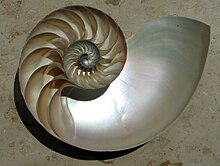Phragmocone: Difference between revisions
Citation bot (talk | contribs) Added bibcode. | Use this bot. Report bugs. | Suggested by Abductive | [[Category:Cephalopod zootomy] | #UCB_Category 40/42 |
m Disambiguating links to Shell (link changed to Exoskeleton) using DisamAssist. |
||
| Line 1: | Line 1: | ||
[[Image:NautilusCutawayLogarithmicSpiral.jpg|thumb|Cutaway of a nautilus shell showing the chambers]] |
[[Image:NautilusCutawayLogarithmicSpiral.jpg|thumb|Cutaway of a nautilus shell showing the chambers]] |
||
The '''phragmocone''' is the chambered portion of the [[ |
The '''phragmocone''' is the chambered portion of the [[Exoskeleton|shell]] of a [[cephalopod]]. It is divided by [[Septa (biology)|septa]] into [[camera (cephalopod)|camera]]e. |
||
In most [[nautiloid]]s and [[Ammonoidea|ammonoid]]s, the phragmocone is a long, straight, curved, or coiled structure, in which the camarae are linked by a [[siphuncle]] which determines [[buoyancy]] by means of gas exchange. |
In most [[nautiloid]]s and [[Ammonoidea|ammonoid]]s, the phragmocone is a long, straight, curved, or coiled structure, in which the camarae are linked by a [[siphuncle]] which determines [[buoyancy]] by means of gas exchange. |
||
Revision as of 10:36, 23 June 2024

The phragmocone is the chambered portion of the shell of a cephalopod. It is divided by septa into camerae.
In most nautiloids and ammonoids, the phragmocone is a long, straight, curved, or coiled structure, in which the camarae are linked by a siphuncle which determines buoyancy by means of gas exchange.
Despite this benefit, such a large shell adds to the mass of the animal, and hence is disadvantageous in catching fast-moving prey. Some nautiloids, such as the Silurian Ascocerida, dropped the phragmocone upon maturity, presumably to increase speed and maneuverability. They thus became the early Paleozoic equivalent of coleoids. The early coleoids and belemnoids adopted a different approach: the phragmocone was retained but became internal and reduced. In general the shell in cephalopods tends to be vestigial or absent.
Fossil record
Being the only biomineralised part of most cephalopods, the phragmocone is typically the only part to enter the fossil record. It is sometimes infilled with sediment, with sediment presumably getting in through the siphuncle.[1] There are occasions where trilobites have been preserved within phragmocones, presumably where they crawled in for refuge.[2]
References
- ^ Henderson, ROBERT A.; McNamara, Kenneth J. (1985). "Taphonomy and ichnology of cephalopod shells in a Maastrichtian chalk from Western Australia". Lethaia. 18 (4): 305. Bibcode:1985Letha..18..305H. doi:10.1111/j.1502-3931.1985.tb00710.x.
- ^ Arnold Davis, R. H. B. Fraaye, Char, Richard (2001). "Trilobites within nautiloid cephalopods". Lethaia. 34 (1): 37–45. Bibcode:2001Letha..34...37D. doi:10.1080/002411601300068251.
{{cite journal}}: CS1 maint: multiple names: authors list (link)



